Nevada’s Mount Irish Archaeological Site – who cares? No one is searching for travel during a Pandemic. There are bigger, more pressing concerns. I’m not sticking my head in the sand; as I’m writing this I know the situation we are in is life changing. But I also know that it doesn’t hurt to dream. Dreams elevate and keep us going through dark times. This is why – even though no one is searching for travel at time of writing – I am going to keep writing travel content.
Jonas Salk was an American physician and medical researcher who developed one of the first successful polio vaccines. Salk once said, “I’ve had dreams and I’ve had nightmares. I overcame the nightmares because of my dreams.”
I like that.
I’m going to overcome my fears by dreaming of places to go and things to see and do. I hope you’ll come along for the virtual trip and put these dreams in your pocket, ready to pull out when travel once again becomes something people are searching for online.
And I’m starting here, with Nevada’s Mount Irish Archaeological Site.
Disclosure: This post contains Affiliate links.
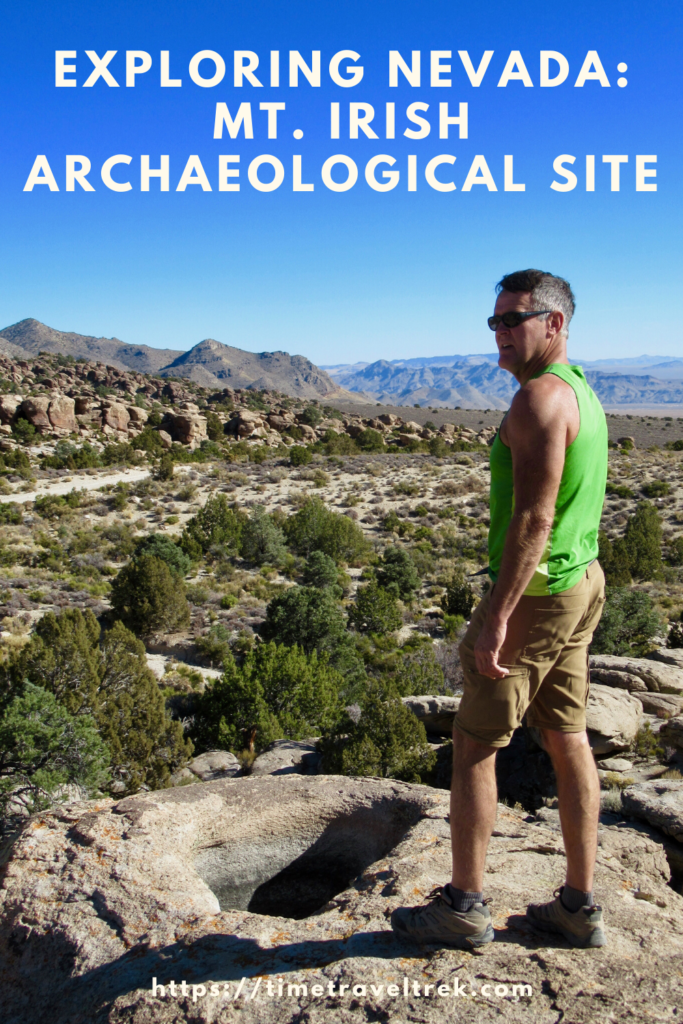
Table of Contents
Making A New Discovery
We were travelling through Nevada on a detour to avoid the hustle and bustle of I-15 through Salt Lake City, Utah. Along the way, we discovered Cathedral Gorge State Park and the historic mining town of Pioche, Nevada. In the visitor centre, we picked up a free newspaper called Treasure Hill Chronicles because it had information about a walking tour.
The next day, Brad read the paper more closely and saw a little corner advertisement for Mount Irish Rock Art & Archaeological District. Mount Irish? We’d never heard of it, but the promise of rock art had us firing up Google. What a find!
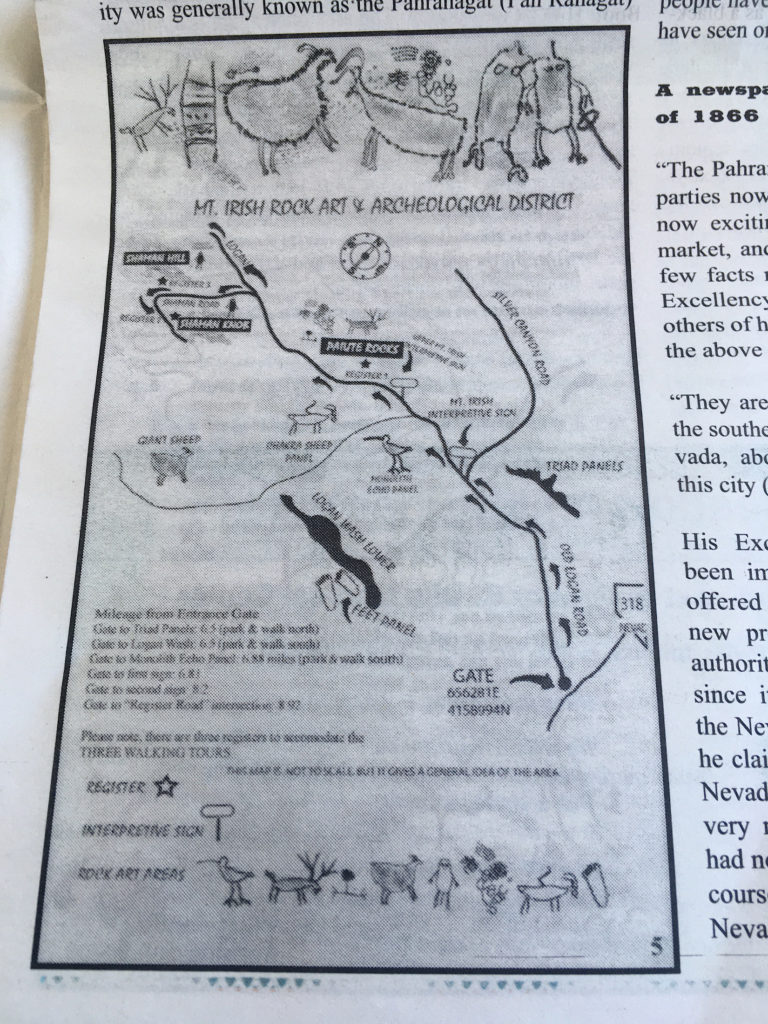
Mount Irish Archaeological Site
Mount Irish Archaeological District is located on the eastern edge of the Mount Irish Range. The District spans across 640 acres. It includes prehistoric rock art and campsites. Its landscape is made up of tuff – or solidified volcanic ash – knolls and outcrops, water-worn rubble spreading out into alluvial fans and washes.
The rock art was created by Native American peoples who used the area from the nineteenth century back to 4,000 years ago. Mount Irish is one of the most important archaeological areas in eastern Nevada. How did we not know of its existence before now?
Discovering rock art – from petroglyph sites to pictographs in caves to desert geoglyphs – is one of our travel passions. While we might not have known it was there before, we wasted no time in heading over to check it out.
Love archaeology? You might also enjoy reading about Portugal’s Côa Valley Archaeological Park!
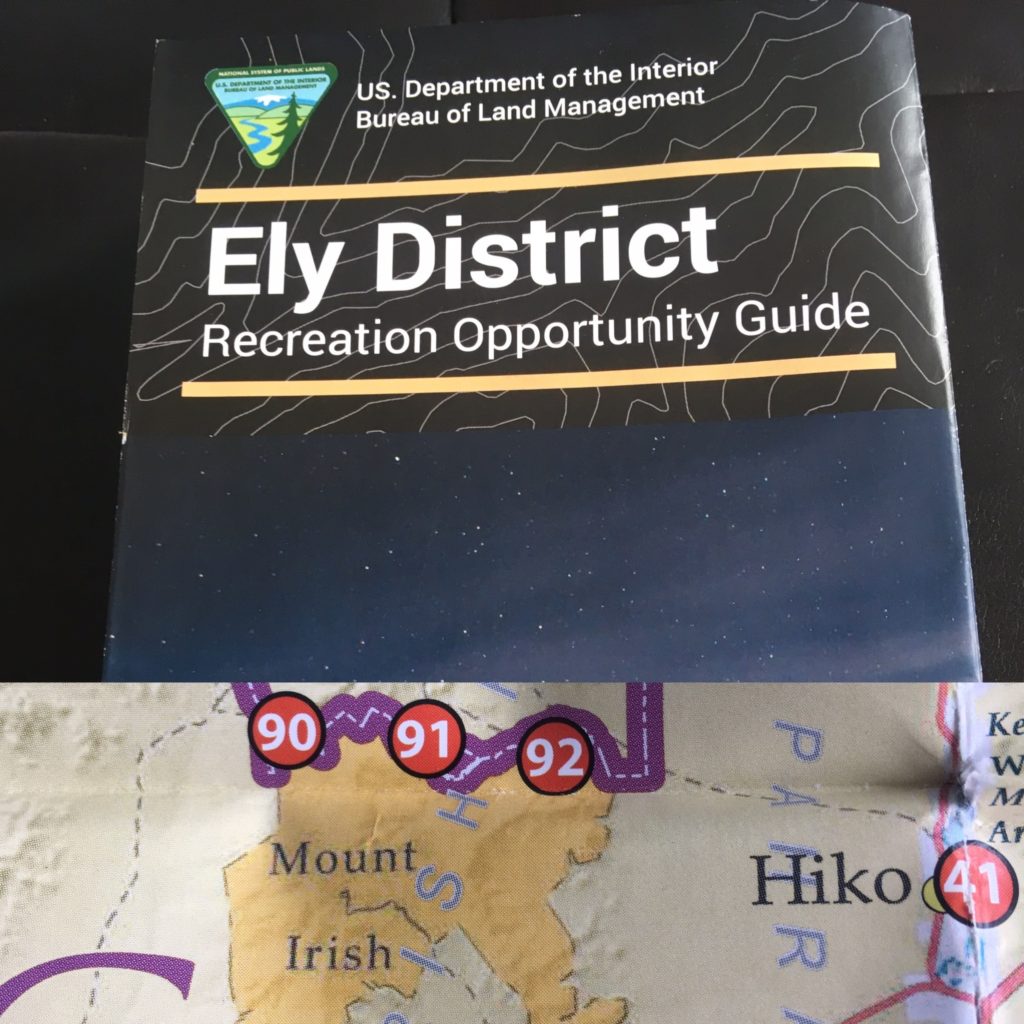
Getting There
The Mount Irish Archaeological Site is located in the northwestern edge of the Pahranagat Valley, about 110 miles north of Las Vegas. We accessed it by heading south on U.S. Route 93 from Panaca, Nevada. It was about 59 miles (95 km) through Caliente to the junction of U.S. 93 and State Route 318 near Crystal Springs.
We followed S.R. 318 north for about 2.5 miles (4 km) to the unmarked road on the left (west side of the road) just past Nesbitt Lake and the Key Pittman Management Area. Opening the barbed wire gate, we drove through, closed the gate and bounced along the gravel road heading westward for less than 7 miles (11 km) to the BLM marker sign for the Mount Irish Archaeological site.
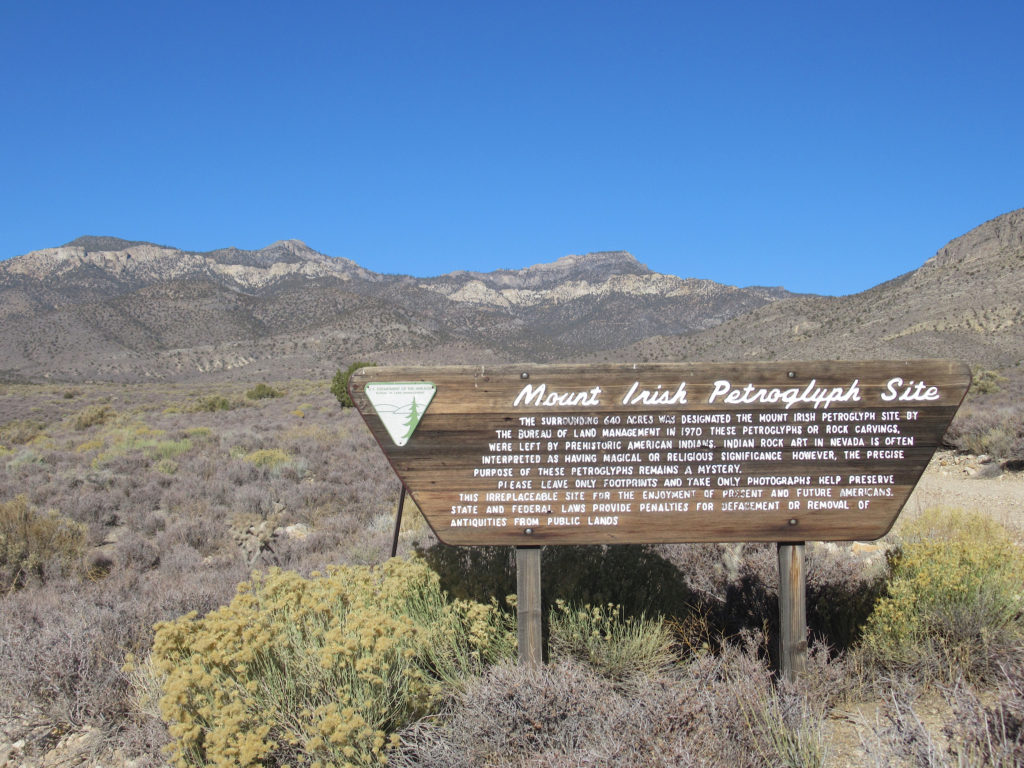
From here, the road splits and splits again and becomes more rugged, especially after heavy rains. After crossing a large wash, continue straight at the next fork. It was signed for Mt. Irish Wilderness Area when we were there. Less than 2 miles (3 km) from the first BLM marker sign, you will see a second, identical sign and a small gravel pullout. This is Paiute Rock, the first of the incredible Mt. Irish rock art sites we were about to discover.
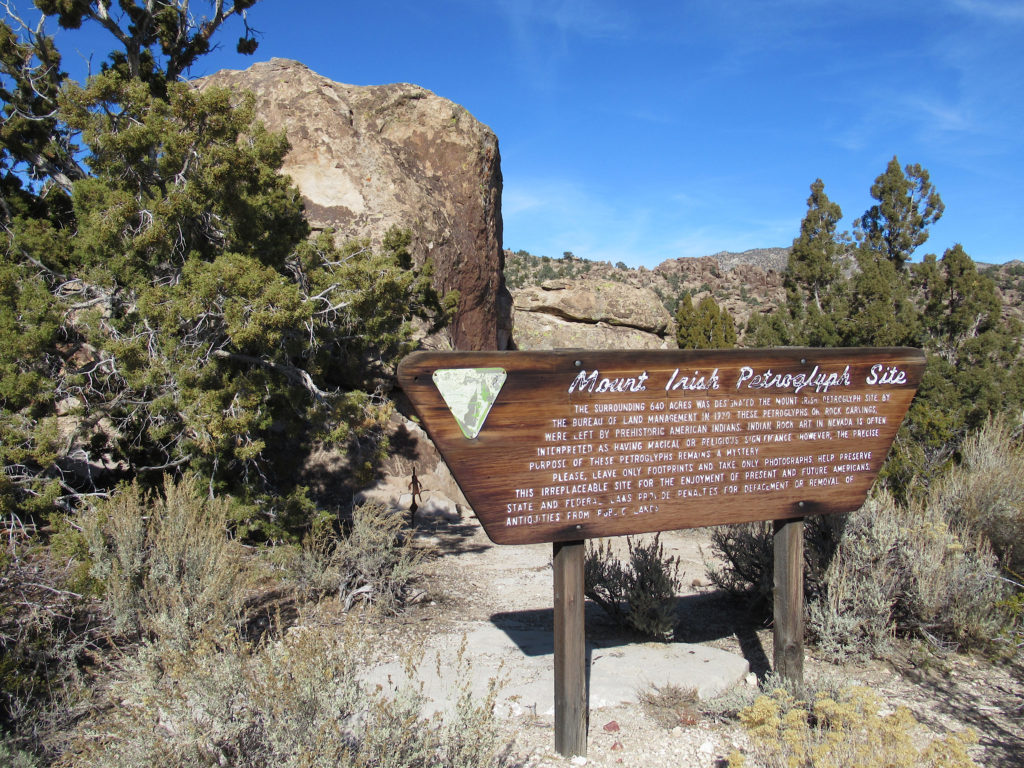
Get the Guides
A BLM register box held two precious keys – copies of the Lincoln County Nevada rock art brochure entitled: Get Primitive and the BLM/NRAF Rock Art pamphlet for the Mt. Irish Archaeological District. The first brochure includes details on Mt. Irish as well as other rock art sites in Lincoln County. The second pamphlet focuses specifically on the Mt. Irish site.
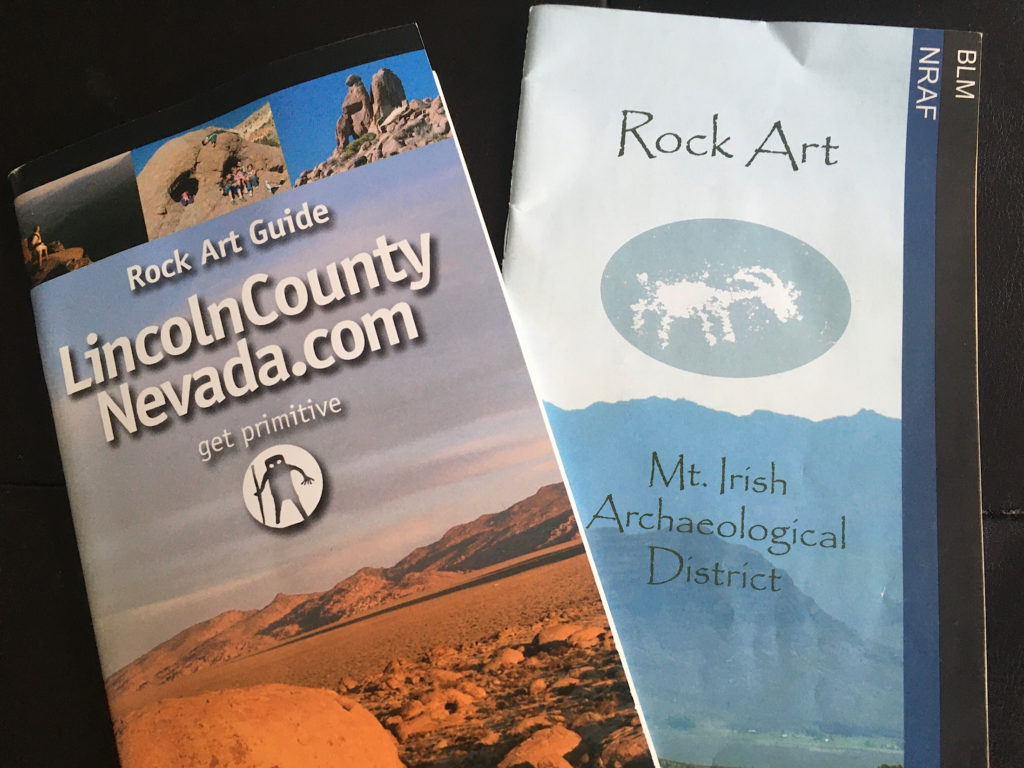
We used both resources in conjunction. The Get Primitive brochure offered numbered information matching each of the rusted metal markers pounded into the ground below the panels at Paiute Rock and Shaman Hill & Knob. The Rock Art pamphlet offered additional information for a total of 11 distinct panel areas in the district.
Paiute Rock Petroglyphs
Guides in hand we set off, hunting for hidden metal markers that led us counter-clockwise around the pile of boulders that is Paiute Rock. Paiute Rock is one of the largest rock art sites in the area, with 80 rock art panels. There are supposed to be a total of nine metal markers highlighting the panels around Paiute Rock. A few of the markers were missing, some were found lying on the ground – all of which made for an interesting quest.
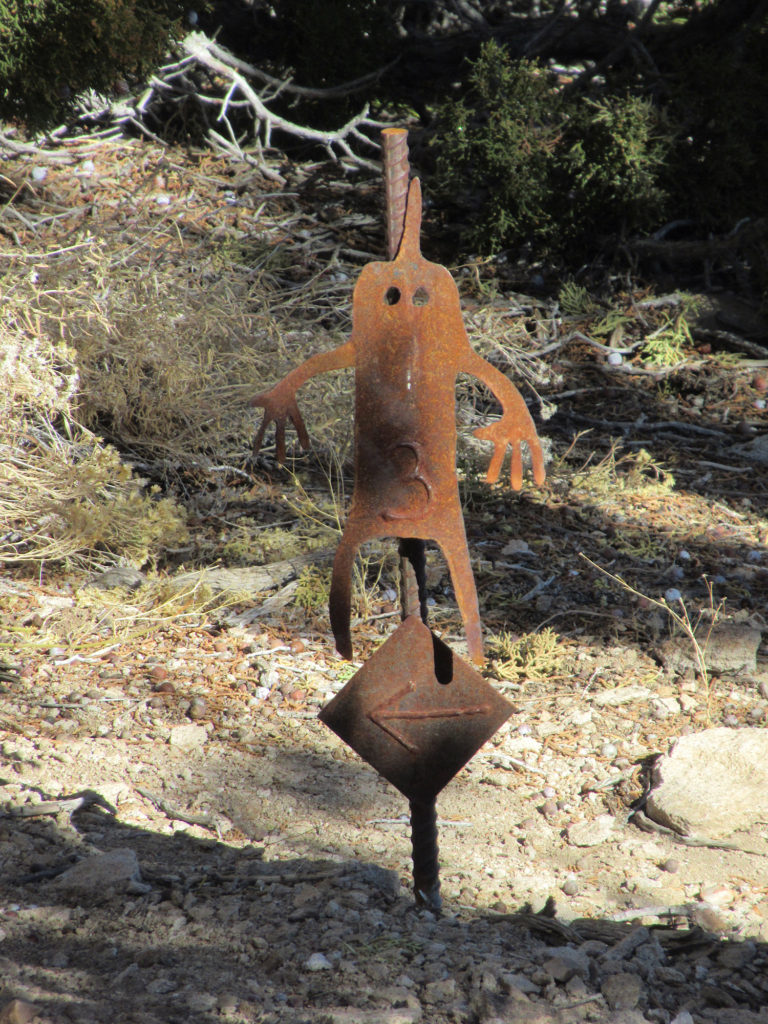
Directly behind marker #1 was a low rock covered with rock art. One image near the top of the panel looks like atlatl. This prehistoric dart thrower was used prior to the bow and arrow – more than 1,500 years ago.
Our jaws dropped as the numbers of petroglyphs grew at every turn – from single bighorn sheep etched in rock pockets to human (anthropomorphic) and animal-like (zoomorphic) figures to curvilinear elements, ladders, rakes, dots and multiple circles. It was discovery and adventure at every turn.
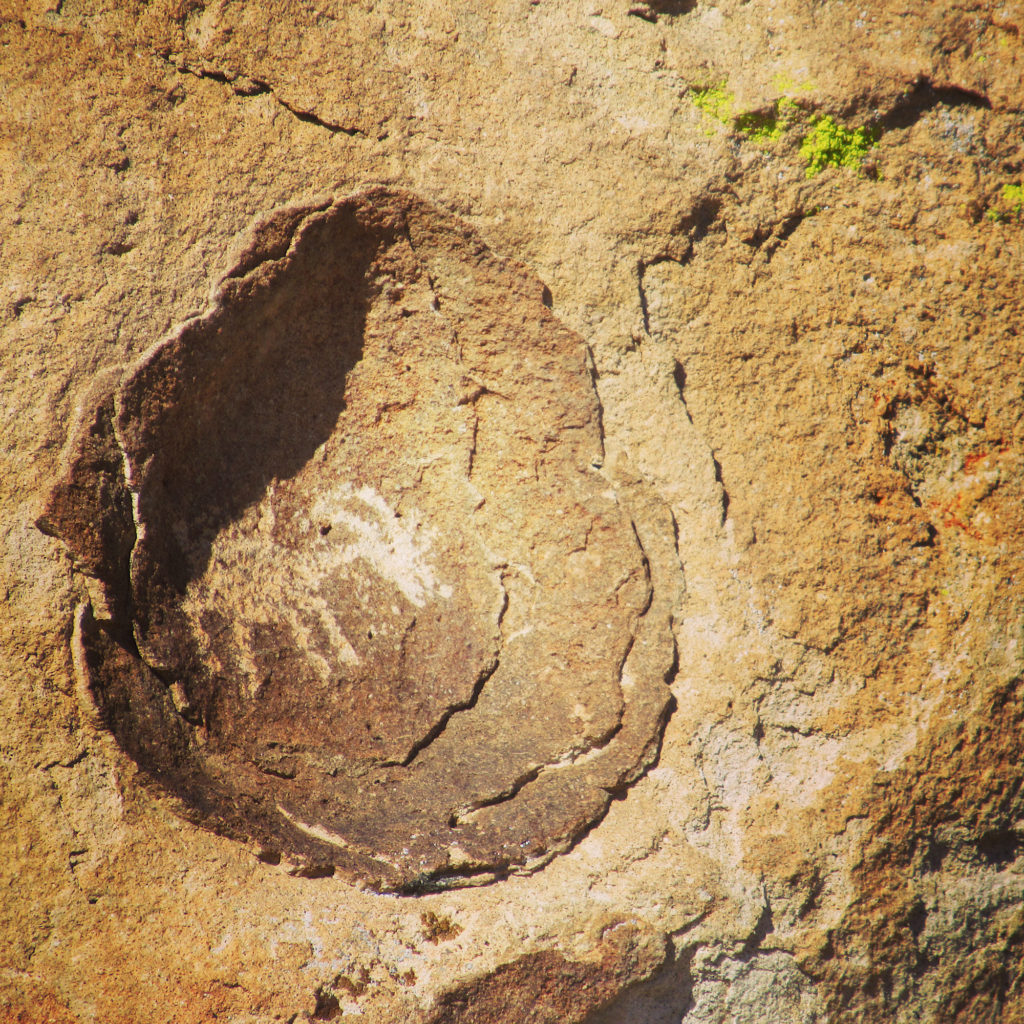
Sacred Sites at Shaman Hill
After a quick snack and some water at the truck, we walked up the road another 0.3 miles (0.5 km) to the Shaman junction on the left. Up the hill where the road ends are two sites: Shaman Knob on the left and Shaman Hill on the right. Both have registration boxes.
Shaman Hill is the largest rock art site in the Mt. Irish Archaeological District. There are an astonishing 129 panels. It is a bit tricky to follow as the trail starts heading off to the right with markers #1 through #4, but then continues to the left for #6 to #8. It doesn’t loop around and we never did find a marker #5. We did manage to find the “Pahranagat Man” or “P-Man” image at marker #3.
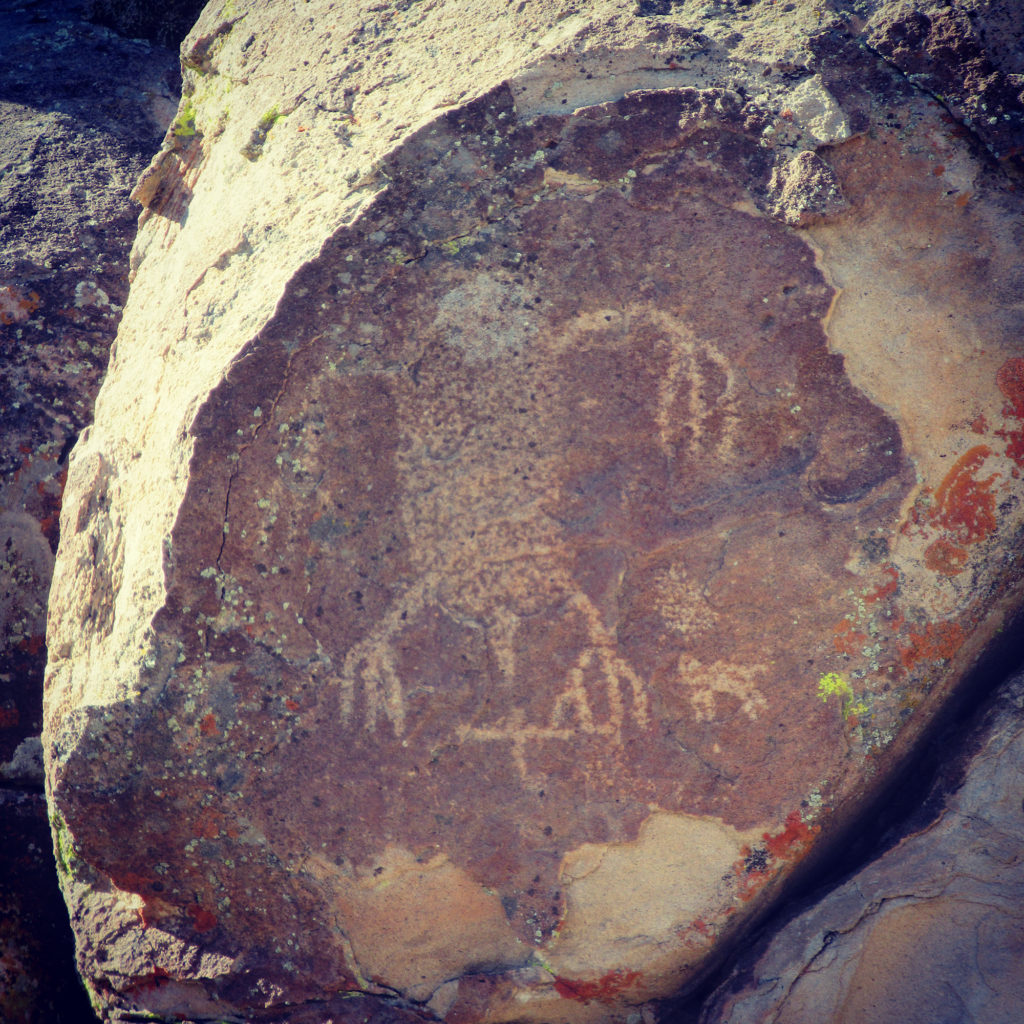
“P-Man” is an anthropomorphic figure unique to the Pahranagat Valley. It is believed to be spiritual or supernatural in nature. Many of these figures have “attendants” or “protectors” that are smaller images near their feet or heads. Did you pick up on the resemblance of this image to that of the marker signs?
Shaman Knob
Across the road is a second registration box and four more panels – the first of which are high on the rock face. We followed the arrows leading past the panel in the natural rock passageway, appreciated the Pahranagat figure at marker #3 and mused on the “spaceship” and “alien” figures at #4.
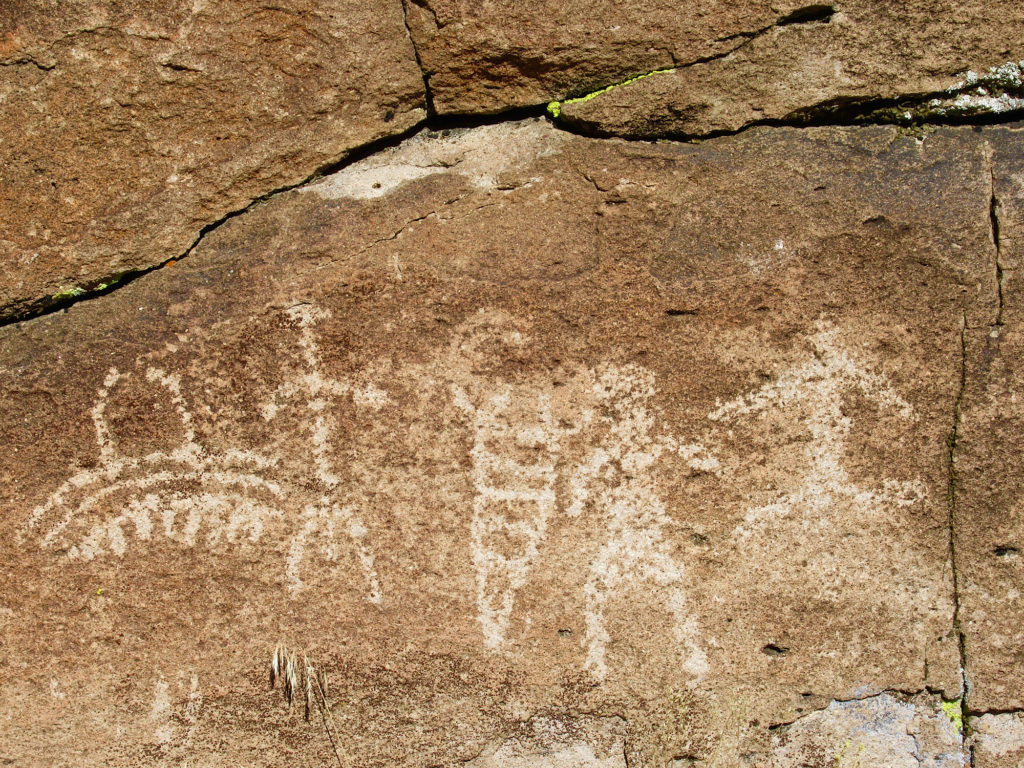
Climbing up on top of the knob gave us an overview of Shaman Knob, Shaman Hill and Paiute Rock as well as distant sites waiting for our return. Yes, I’m putting this travel dream in my pocket.
Next time, we will start earlier in the day, walk in past the signed “Mt. Irish” junction and explore the concentration of panels on that grouping of rocks. We’ll stop and send a shout across the Echo Rock group – and that shout will bounce back saying “dreams matter.”
Further Information
The Bureau of Land Management page for the Mt. Irish Archaeological Site includes a link to the Mt. Irish brochure produced by the Nevada Rock Art Foundation. For additional details about the Mount Irish site and Lincoln County, Nevada, check out the county website (listed above in Get the Guides) as well as Travel Nevada.
We stayed in Snow Canyon State Park, Utah and did this a day trip – an option if you don’t mind the drive.
Search for other Nevada adventures? Check out 11 Amazing Things to Do in Boulder City | Nevada or Valley of Fire: Prospect Trail and More Hikes.

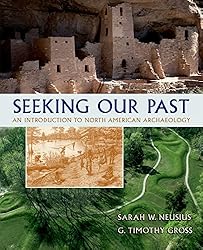

Wow! You are so right that we need to keep dreaming. What a great article and wonderful pictures. I love how different some of the rock art is. And the signs, I want one in my yard.
Thank you Susanah. Knew you’d love the signs – but you’ll have to settle for the pic as we left them all where we found them!
This is a great article.
Thanks Tangie!
Incredible! I had no idea about this. Thanks for brining awareness and for the great read!
You are more than welcome, Marie! There is so much to see in the big, beautiful world of ours – and one day we will set out to explore it again.
I enjoyed reading your article and especially liked the conclusion about “dreams that matter.” Native American rock art is facinating and also the legends behind it. It was very interesting to learn that “Pahranagat Man” and other petroglyphs have a “protector” image next to them.
Thanks for the comment, Natalia. Absolutely, visiting and learning about Native American rock art sites is a drawing card for travel throughout the American Southwest.
I’m with you, even though we can’t travel right now, I’m still dreaming of my next adventure. Thanks for sharing this article. It looks like a great place to have on my travel list.
Keep dreaming, Patricia! One day this will all be a distant memory and we’ll ticking off the boxes on our lists.
What an interesting area! Off the proverbial beaten path, I’m glad you stopped to investigate and share your experience.
Thanks Darla! Always love the sense of discovery in finding a “new” place!
Looks like an interesting place to visit!
Agreed, Tim! In fact it’s worthy of multiple visits.
It’s always a deep experience for me to see rock art. Rock art, sadly is not a big deal for most people here (Canada).
My time viewing the pictographs of Seminole Canyon H.S.P., in Texas, opened my journey exploring rock art. Never stop dreaming … they may come true.
Appreciate your comments, Paul. Thx for reminding me of Seminole Canyon! We visited there a few years ago on our way to Big Bend NP. So many incredible windows to the past to discover.
Amazing! We are also missing travel and would be somewhere adventuring in Desert SW right now..if it were possible and safe! Glad to have found this through a like on my Insta @mtnsurff. So many amazing Petroglyph sites make a nice walk to let the imagination wander and wonder what life must have been like there for the 1st nations there so long ago. Hit me up up if you want to know a few favorites South of SLC. Keep travelling and wandering near or far!
Thx for the msg, Cory! Always happy to connect with like-minded individuals. Deets on getting your free copy of the ebook of travel misadventures is winging your way. Been making Covid goals and the ebook project was one! Next up is getting a new post up on the blog before the middle of the week – a paddle trip down the San Juan River with petroglyphs, pictographs and dozens of ruins. Yes, so many amazing sites to see – adventure on! P.S. Already follow @mtnsurff – loved the bearberry snap!